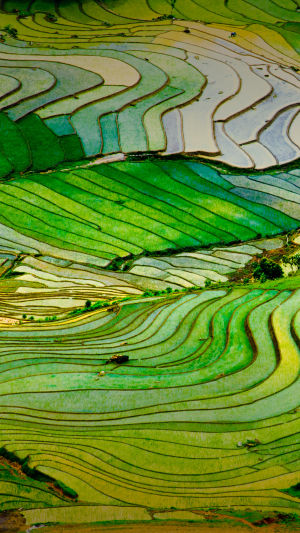A terrace is a field with a strip terrace or wavy section built along the contour line on the hilly slope. It is an effective measure to control soil and water loss in sloping farmland.
Terraced fields have better ventilation and light transmittance conditions, which are conducive to crop growth and nutrient accumulation. According to the different slopes of the field surface, there are horizontal terraces, slope terraces, compound terraces, etc. The width of the terrace depends on the slope of the ground, the thickness of the soil layer, the cultivation method, the amount of labour, and economic conditions.
In many parts of the world, there are terraces, which run up steep hillsides like steps for giants to ascend to the sky. Terraces are flat areas cut into hillsides for growing crops. It's one of the most amazing ways humans have altered the surface of the earth.
Terraces first appeared in prehistoric times. At first, the forest or hilltops were cleared to grow some food, or as fortifications. Around the same time, these types of terraces began to appear around the world. Building terraces can weaken and prevent soil erosion. The reason is that the slope of the field is reduced and the erosion effect of water is weakened. The ridge is slightly higher than the terrace surface, which can ensure that water and fertilizer are not easy to flow out of the field and play a role in soil and water conservation.
There are two main sources of water in the terraces. One is the rain from the sky, the other is the groundwater.
We all know that terraces are built on mountains, but they are on the mountainside and the foot of the mountain, and the top of the mountain is usually forest. And in the forest, many trees produce water, and where there is a forest, there is almost always water.
Another source is rain. Terraces are usually located in subtropical climates. It rains more all year round, and the local soil holds water well.
Three major terraces in the world:
1. Hani Rice Terraces in China.
People far away from the Central Plains in the strong perseverance of the agricultural civilization, absorb nature and nourish history. The terraces have become the cultural and spiritual sustenance of their nation. Water is the soul of the terraces, and it nourishes the spirit of the Hani nation. With the opening of aeroplanes and the cutting off of secondary roads, this isolated place began to communicate with modern times.
2. Banaway Terraces, Philippines.
The Banaway Mountain Terraces are a famous ancient wonder of the Philippines. It is on banknotes issued by the Philippines and is one of the symbols of the Philippines. The World Heritage Committee put it on the World Heritage List in 1992. Burn away Mountain terraces are ancient rice terraces built by the Ifugao people in the Philippines more than 2000 years ago at a height of 1,500 meters above sea level.
The largest terraces cover 1/4 hectare and the smallest only 4 square meters. The terraces are made of stone, with walls as high as 4 meters and as low as 2 meters. The irrigation canals, which are like winding hills and steps, are raised layer by layer.
The total length of the terraces is 19,000 kilometres. The Barnaway rice terraces, a masterpiece of the ancient Ifugao people of the Philippines, built entirely by hand on the high mountains, are not only a magnificent sight but also a reflection of the Ifugao people's talent for engineering.
3. Lavotte Fields, Switzerland.
The 30-kilometre vineyard on the shores of Lake Geneva is a gift from nature and the result of hard work by humans. Generations of viticulturists have terraced the land and built stone walls to support it. The Lavau region has greatly contributed to the development of Lausanne and its surrounding areas but is also threatened by urbanization. However, the protection and support for the area have been exemplary.





